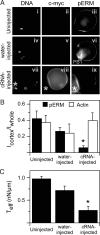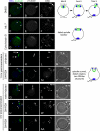Cortical mechanics and meiosis II completion in mammalian oocytes are mediated by myosin-II and Ezrin-Radixin-Moesin (ERM) proteins
- PMID: 20660156
- PMCID: PMC2938384
- DOI: 10.1091/mbc.E10-01-0066
Cortical mechanics and meiosis II completion in mammalian oocytes are mediated by myosin-II and Ezrin-Radixin-Moesin (ERM) proteins
Abstract
Cell division is inherently mechanical, with cell mechanics being a critical determinant governing the cell shape changes that accompany progression through the cell cycle. The mechanical properties of symmetrically dividing mitotic cells have been well characterized, whereas the contribution of cellular mechanics to the strikingly asymmetric divisions of female meiosis is very poorly understood. Progression of the mammalian oocyte through meiosis involves remodeling of the cortex and proper orientation of the meiotic spindle, and thus we hypothesized that cortical tension and stiffness would change through meiotic maturation and fertilization to facilitate and/or direct cellular remodeling. This work shows that tension in mouse oocytes drops about sixfold during meiotic maturation from prophase I to metaphase II and then increases ∼1.6-fold upon fertilization. The metaphase II egg is polarized, with tension differing ∼2.5-fold between the cortex over the meiotic spindle and the opposite cortex, suggesting that meiotic maturation is accompanied by assembly of a cortical domain with stiffer mechanics as part of the process to achieve asymmetric cytokinesis. We further demonstrate that actin, myosin-II, and the ERM (Ezrin/Radixin/Moesin) family of proteins are enriched in complementary cortical domains and mediate cellular mechanics in mammalian eggs. Manipulation of actin, myosin-II, and ERM function alters tension levels and also is associated with dramatic spindle abnormalities with completion of meiosis II after fertilization. Thus, myosin-II and ERM proteins modulate mechanical properties in oocytes, contributing to cell polarity and to completion of meiosis.
Figures







Similar articles
-
Ran GTPase promotes oocyte polarization by regulating ERM (Ezrin/Radixin/Moesin) inactivation.Cell Cycle. 2013 Jun 1;12(11):1672-8. doi: 10.4161/cc.24901. Epub 2013 May 8. Cell Cycle. 2013. PMID: 23656777 Free PMC article.
-
Phosphorylated ERM regulates meiotic maturation in mouse oocytes.Biochem Biophys Res Commun. 2024 Nov 19;734:150602. doi: 10.1016/j.bbrc.2024.150602. Epub 2024 Sep 6. Biochem Biophys Res Commun. 2024. PMID: 39243677
-
Differential expression and functions of cortical myosin IIA and IIB isotypes during meiotic maturation, fertilization, and mitosis in mouse oocytes and embryos.Mol Biol Cell. 1998 Sep;9(9):2509-25. doi: 10.1091/mbc.9.9.2509. Mol Biol Cell. 1998. PMID: 9725909 Free PMC article.
-
The spatial and mechanical challenges of female meiosis.Mol Reprod Dev. 2011 Oct-Nov;78(10-11):769-77. doi: 10.1002/mrd.21358. Epub 2011 Jul 19. Mol Reprod Dev. 2011. PMID: 21774026 Free PMC article. Review.
-
Symmetry breaking and polarity establishment during mouse oocyte maturation.Philos Trans R Soc Lond B Biol Sci. 2013 Sep 23;368(1629):20130002. doi: 10.1098/rstb.2013.0002. Print 2013. Philos Trans R Soc Lond B Biol Sci. 2013. PMID: 24062576 Free PMC article. Review.
Cited by
-
A condensate dynamic instability orchestrates actomyosin cortex activation.Nature. 2022 Sep;609(7927):597-604. doi: 10.1038/s41586-022-05084-3. Epub 2022 Aug 17. Nature. 2022. PMID: 35978196 Free PMC article.
-
Polarized Cdc42 activation promotes polar body protrusion and asymmetric division in mouse oocytes.Dev Biol. 2013 May 1;377(1):202-12. doi: 10.1016/j.ydbio.2013.01.029. Epub 2013 Feb 4. Dev Biol. 2013. PMID: 23384564 Free PMC article.
-
Myosin-X is dispensable for spindle morphogenesis and positioning in the mouse oocyte.Development. 2021 Apr 1;148(7):dev199364. doi: 10.1242/dev.199364. Epub 2021 Apr 15. Development. 2021. PMID: 33722900 Free PMC article.
-
How great thou ART: biomechanical properties of oocytes and embryos as indicators of quality in assisted reproductive technologies.Front Cell Dev Biol. 2024 Feb 15;12:1342905. doi: 10.3389/fcell.2024.1342905. eCollection 2024. Front Cell Dev Biol. 2024. PMID: 38425501 Free PMC article. Review.
-
Cortical mechanics and myosin-II abnormalities associated with post-ovulatory aging: implications for functional defects in aged eggs.Mol Hum Reprod. 2016 Jun;22(6):397-409. doi: 10.1093/molehr/gaw019. Epub 2016 Feb 26. Mol Hum Reprod. 2016. PMID: 26921397 Free PMC article.
References
-
- Azoury J., Lee K. W., Georget V., Rassinier P., Leader B., Verlhac M. H. Spindle positioning in mouse oocytes relies on a dynamic meshwork of actin filaments. Curr. Biol. 2008;18:1514–1519. - PubMed
-
- Barrett S. L., Albertini D. F. Allocation of gamma-tubulin between oocyte cortex and meiotic spindle influences asymmetric cytokinesis in the mouse oocyte. Biol. Reprod. 2007;76:949–957. - PubMed
-
- Bretscher A., Edwards K., Fehon R. G. ERM proteins and merlin: integrators at the cell cortex. Nat. Rev. Mol. Cell Biol. 2002;3:586–599. - PubMed
-
- Brunet S., Maro B. Cytoskeleton and cell cycle control during meiotic maturation of the mouse oocyte: integrating time and space. Reproduction. 2005;130:801–811. - PubMed
Publication types
MeSH terms
Substances
Grants and funding
LinkOut - more resources
Full Text Sources
Other Literature Sources
Molecular Biology Databases
Research Materials

